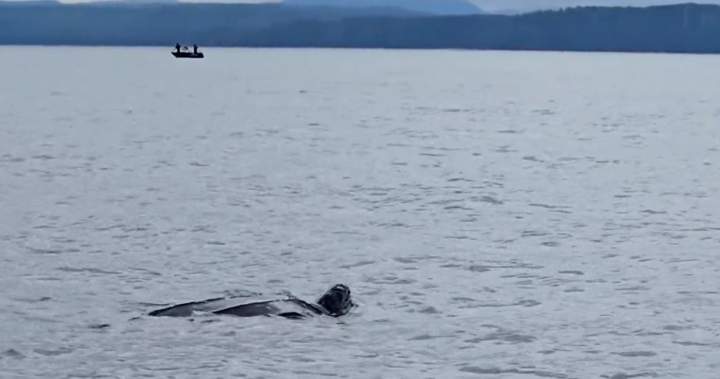Emergency room nurse Victoria Bradshaw was just getting ready to fish off the coast of Haida Gwaii last Monday when she saw a large head pop up out of the water.
“At first I thought it was a sea lion,” she told Global News.
Turns out, it was a one of the largest sea turtles in the world.
“I grabbed my phone right away because this ginormous animal was just kind of cruising by us,” Bradshaw said.
“We very quickly turned off the motors because again, that’s super important for all marine wildlife, but we just felt so grateful that he came up pretty much within 20, 30 feet of the back of the boat, which is why we were so quick with that and I was able to capture that video.”
She said the turtle cruised along the surface for about 30 seconds before disappearing.
What Bradshaw and others on that boat had seen was a leatherback sea turtle, which is very rare to see in B.C. waters – there have only been 149 sightings recorded off B.C.’s coast since 1931.

Get daily National news
Get the day’s top news, political, economic, and current affairs headlines, delivered to your inbox once a day.
“It was absolutely wonderful, not just to know that there was a sighting and what that could do for awareness, engagement, people caring,” Jackie Hildering, education and communications director with the Marine Education and Research Society (MERS), said.
The leatherback turtle travels from Indonesia to eat jellyfish off the B.C. coast and is the only sea turtle that belongs in the province’s waters.
Hildering said they are considered an endangered species in Canada.
“They are astoundingly adapted as well to slurp in jellies,” she added.
“That’s why it’s worth them coming all the way from Indonesia to these rich waters to feed. They have all these cusps down their throat, but it’s also, I mean, they need to feed that way, feed really efficiently by slurping down jellyfish, but they can’t discern the jellys from balloons and floating plastics. So they’re a powerful ambassador as well.”
Hildering said that is why it is so important not to dispose of plastic and garbage into the oceans.
“What we want people to know more than anything is they’re out there, you know?” she added. “Leatherbacks belong in our waters on this vast coastline. Endangered leatherback turtles belong. They are remarkable. They come here because it’s worth it.”
Bradshaw said she never would have expected to see a leatherback turtle off the coast of Haida Gwaii. The last sighting of one was in 2008.
“You never expect to see that in our waters,” she said.
“I don’t know why, you know, whales and different things, which are still absolutely magnificent to me even now, but to see something so large, I just didn’t even realize that they got that big in all fairness.
“And I just felt very lucky that he or she decided to actually kind of surface in that way.”
Read the full article here
